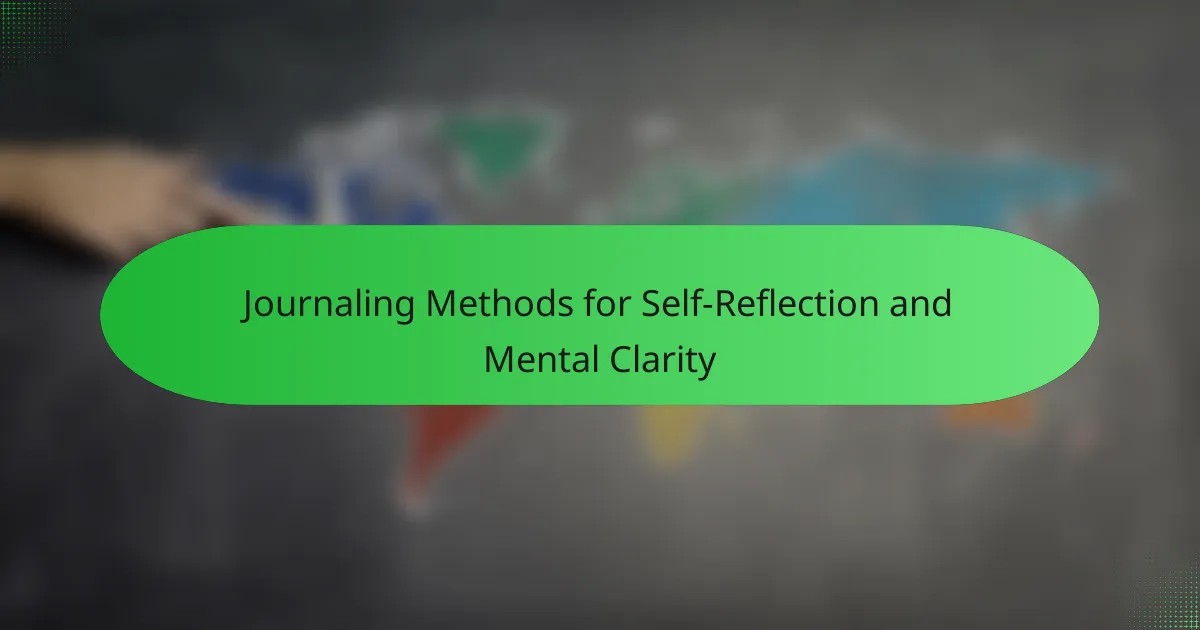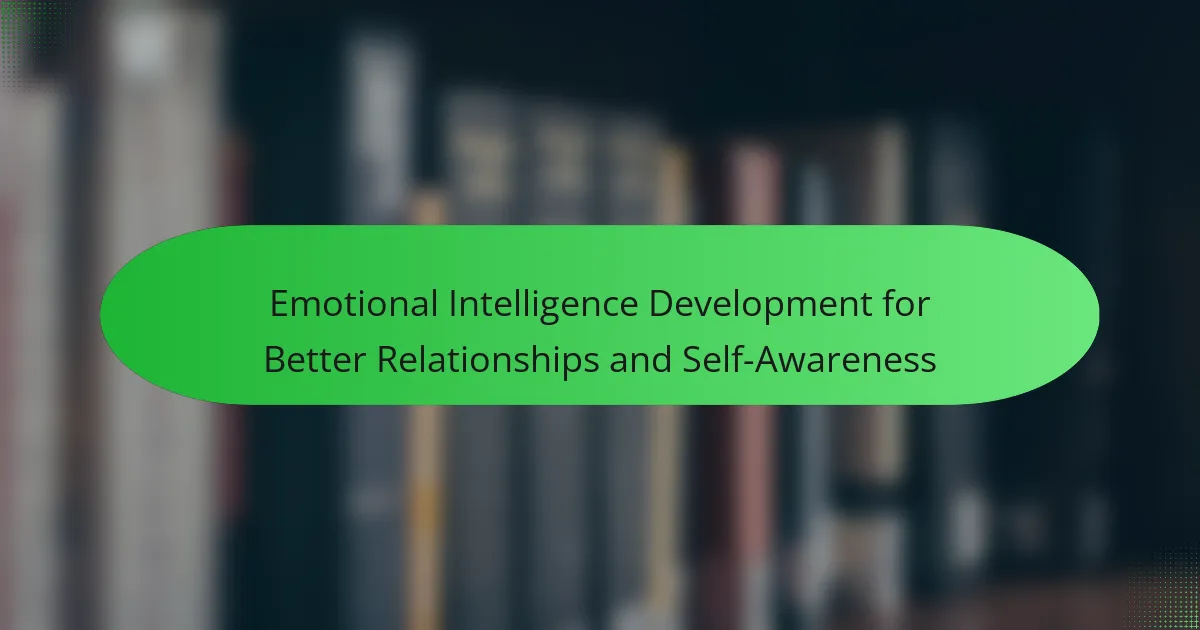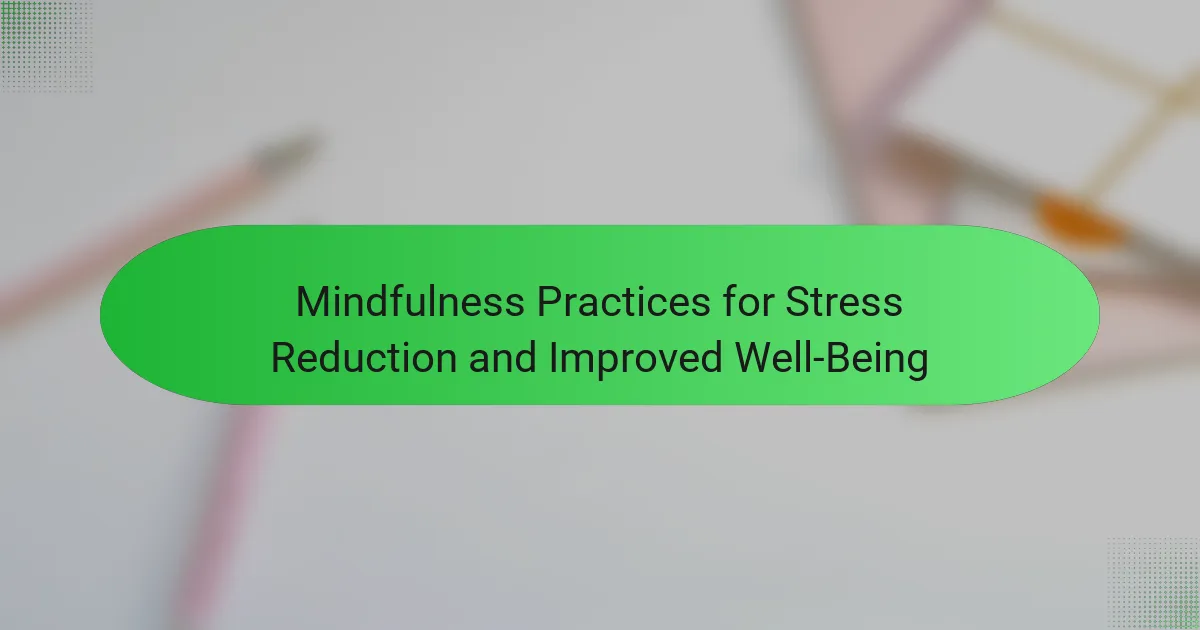Cognitive Behavioral Therapy (CBT) techniques enhance personal growth and emotional resilience by promoting self-awareness and adaptive thinking. Key approaches include cognitive restructuring to challenge negative beliefs, exposure therapy to reduce anxiety, and mindfulness practices for emotional regulation. These strategies empower individuals to confront challenges, improve coping skills, and foster a stronger sense of self-efficacy. By applying these techniques consistently, individuals can achieve significant improvements in mental well-being and personal development.
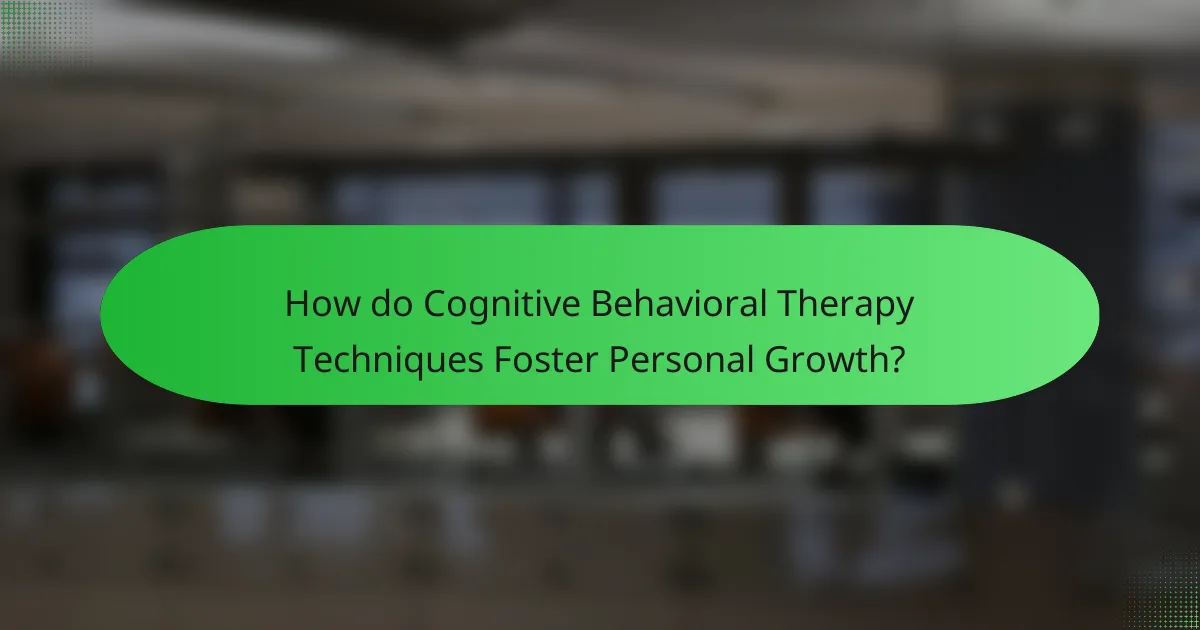
How do Cognitive Behavioral Therapy Techniques Foster Personal Growth?
Cognitive Behavioral Therapy techniques significantly enhance personal growth and emotional resilience by promoting self-awareness and adaptive thinking. These techniques empower individuals to identify negative thought patterns and replace them with constructive alternatives.
One effective technique is cognitive restructuring, which helps individuals challenge irrational beliefs. This process fosters a growth mindset, encouraging resilience in the face of adversity. Additionally, exposure therapy gradually desensitizes individuals to anxiety-provoking situations, enhancing coping strategies.
Mindfulness practices integrated into CBT improve emotional regulation. By focusing on the present moment, individuals can reduce stress and increase overall well-being. As a result, these techniques collectively foster a stronger sense of self-efficacy and emotional stability.
What are the fundamental principles of Cognitive Behavioral Therapy?
Cognitive Behavioral Therapy (CBT) focuses on changing negative thought patterns to improve emotional well-being. Key principles include cognitive restructuring, behavioral activation, exposure therapy, and mindfulness techniques. These methods enhance personal growth and emotional resilience. Cognitive restructuring helps identify and challenge distorted thinking. Behavioral activation encourages engagement in positive activities. Exposure therapy gradually confronts fears, while mindfulness fosters present-moment awareness. Together, these techniques empower individuals to manage emotions effectively and build resilience.
How can CBT techniques promote self-awareness and reflection?
Cognitive Behavioral Therapy (CBT) techniques enhance self-awareness and reflection by promoting structured thinking and emotional regulation. These techniques encourage individuals to identify negative thought patterns and challenge them, fostering a deeper understanding of their emotions and behaviors.
One effective CBT technique is journaling, which allows individuals to document thoughts and feelings, facilitating reflection on experiences. Another technique is cognitive restructuring, where individuals learn to reframe negative thoughts into positive ones, enhancing self-awareness. Mindfulness practices incorporated in CBT also help individuals stay present, increasing awareness of their thoughts and feelings.
Research indicates that regular practice of these techniques can lead to improved emotional resilience and personal growth. By consistently applying CBT techniques, individuals can develop a more profound understanding of themselves, ultimately leading to healthier coping mechanisms and enhanced emotional well-being.
Which CBT strategies are most effective for developing personal goals?
Cognitive Behavioral Therapy (CBT) strategies that effectively develop personal goals include setting SMART goals, using cognitive restructuring, and practicing self-monitoring. These techniques enhance clarity and motivation.
SMART goals involve creating Specific, Measurable, Achievable, Relevant, and Time-bound objectives. This framework ensures goals are clear and attainable, promoting a structured approach to personal growth.
Cognitive restructuring helps individuals identify and challenge negative thought patterns that hinder goal achievement. By reframing these thoughts, individuals can foster a more positive mindset, essential for pursuing personal aspirations.
Self-monitoring encourages individuals to track their progress and reflect on their actions. This practice increases accountability and provides insights into behaviors that support or obstruct goal attainment.
How does the practice of mindfulness integrate with CBT for personal growth?
Mindfulness enhances Cognitive Behavioral Therapy (CBT) by fostering awareness and acceptance, which promotes personal growth. This integration helps individuals recognize and challenge negative thought patterns while cultivating a compassionate mindset. Research shows that combining mindfulness with CBT increases emotional resilience and reduces anxiety. Mindfulness practices, such as meditation, support the identification of triggers and improve emotional regulation, leading to lasting behavioral changes.
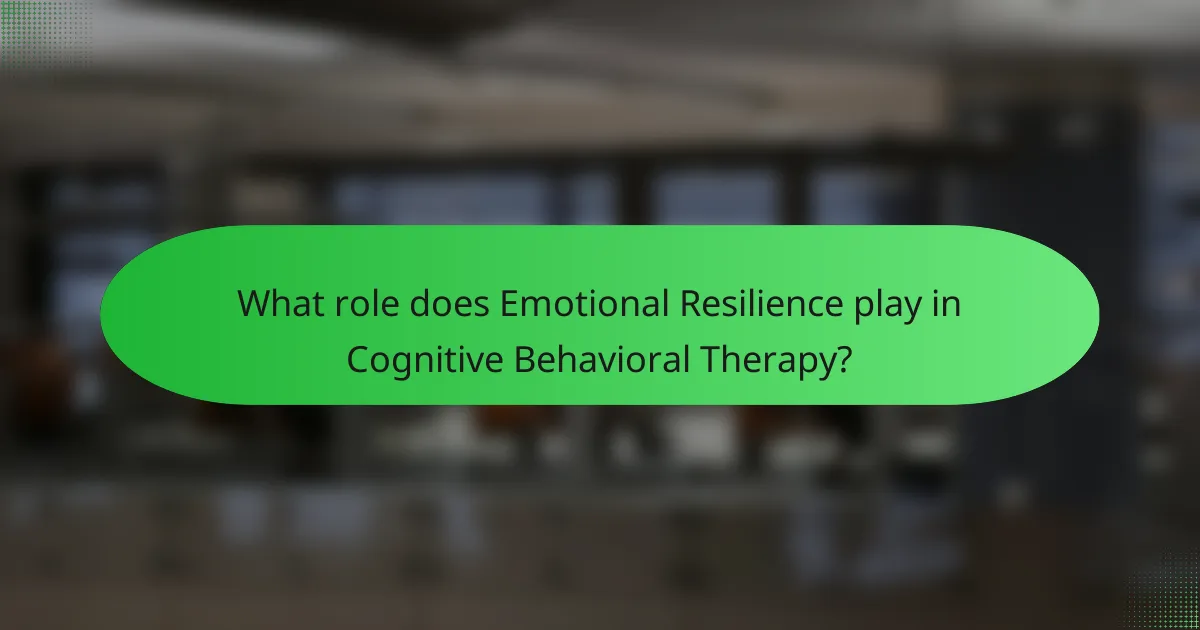
What role does Emotional Resilience play in Cognitive Behavioral Therapy?
Emotional resilience is crucial in Cognitive Behavioral Therapy (CBT) as it enhances coping strategies and emotional regulation. This resilience allows individuals to confront negative thoughts and behaviors effectively. Techniques in CBT, such as cognitive restructuring and exposure therapy, foster emotional resilience by promoting adaptive thinking patterns. As a result, clients experience improved mental well-being and personal growth.
How can CBT techniques enhance emotional resilience?
Cognitive Behavioral Therapy (CBT) techniques significantly enhance emotional resilience by promoting adaptive thinking patterns. These techniques help individuals identify and challenge negative thoughts, leading to improved emotional regulation and coping strategies.
CBT encourages self-awareness, enabling individuals to recognize triggers and develop proactive responses. Techniques such as cognitive restructuring and mindfulness foster a more positive outlook, which contributes to greater resilience. Studies show that individuals practicing CBT report higher levels of emotional stability and reduced anxiety.
By applying these techniques consistently, individuals can build a robust framework for managing stress and adversity, ultimately leading to sustained personal growth and emotional strength.
What are the common emotional challenges addressed by CBT?
Cognitive Behavioral Therapy (CBT) addresses common emotional challenges such as anxiety, depression, stress, and low self-esteem. These issues often stem from negative thought patterns and behaviors. CBT techniques help individuals identify and reframe these thoughts, promoting emotional resilience. For example, cognitive restructuring can alleviate anxiety by challenging irrational fears. Additionally, behavioral activation encourages engagement in positive activities, mitigating depressive symptoms.
Which CBT methods are particularly effective for building coping strategies?
Cognitive Behavioral Therapy (CBT) methods effective for building coping strategies include cognitive restructuring, exposure therapy, and mindfulness techniques. These approaches foster emotional resilience and personal growth by addressing negative thought patterns and promoting adaptive behaviors.
Cognitive restructuring helps individuals identify and challenge distorted thoughts, leading to healthier perspectives. Exposure therapy gradually exposes individuals to feared situations, reducing anxiety over time. Mindfulness techniques enhance awareness and acceptance of thoughts and feelings, improving emotional regulation.
These methods collectively empower individuals to develop practical coping strategies for various life challenges, enhancing overall mental well-being.

Which Cognitive Behavioral Therapy Techniques are most commonly used?
Cognitive Behavioral Therapy techniques commonly used include cognitive restructuring, exposure therapy, behavioral activation, and mindfulness practices. These techniques foster personal growth and enhance emotional resilience.
Cognitive restructuring helps individuals identify and challenge negative thought patterns. Exposure therapy gradually exposes clients to feared situations, reducing anxiety. Behavioral activation encourages engagement in enjoyable activities to combat depression. Mindfulness practices promote present-moment awareness, improving emotional regulation.
Each technique addresses specific mental health challenges, supporting overall well-being.
What is the significance of cognitive restructuring in CBT?
Cognitive restructuring is significant in Cognitive Behavioral Therapy (CBT) as it helps individuals identify and challenge negative thought patterns. This technique enhances emotional resilience by promoting healthier thinking. Cognitive restructuring enables clients to reframe their perspectives, leading to improved emotional regulation and personal growth. By addressing cognitive distortions, individuals can develop a more balanced view of situations, which contributes to better mental health outcomes.
How does exposure therapy work within the framework of CBT?
Exposure therapy works by gradually exposing individuals to anxiety-provoking stimuli within Cognitive Behavioral Therapy (CBT). This technique helps clients confront and process their fears, reducing avoidance behaviors over time.
The process typically involves several key steps. First, therapists identify specific fears with the client. Next, they create a hierarchy of these fears, starting from least to most anxiety-inducing. The client is then exposed to these stimuli in a controlled setting, allowing them to experience their fears without negative consequences.
As a result, clients learn to manage their anxiety responses, leading to improved emotional resilience. Research shows that exposure therapy significantly decreases symptoms of anxiety disorders, enhancing personal growth through increased coping skills.
This technique exemplifies a unique attribute of CBT, which emphasizes actionable strategies for change, making it effective for various emotional challenges.
What are behavioral activation techniques in CBT?
Behavioral activation techniques in Cognitive Behavioral Therapy (CBT) help individuals engage in meaningful activities to improve mood and reduce depressive symptoms. These techniques include identifying values, scheduling enjoyable activities, and tracking progress. By focusing on actions that align with personal values, individuals can enhance emotional resilience. Regular engagement in these activities fosters a sense of accomplishment and motivates further positive behavior.

How can individuals apply CBT techniques in daily life?
Individuals can apply Cognitive Behavioral Therapy techniques daily by practicing self-reflection, challenging negative thoughts, and setting realistic goals. These techniques enhance emotional resilience and promote personal growth.
1. Self-Reflection: Regularly assess thoughts and feelings to identify patterns. This practice fosters self-awareness and understanding.
2. Thought Challenging: Actively dispute negative thoughts by questioning their validity. This helps reduce anxiety and promotes a positive mindset.
3. Goal Setting: Establish achievable short-term and long-term goals. This creates a sense of purpose and direction in daily life.
4. Behavioral Activation: Engage in activities that bring joy or fulfillment. This combats feelings of sadness and enhances overall well-being.
5. Mindfulness: Practice being present in the moment. Mindfulness reduces stress and improves emotional regulation.
6. Journaling: Write about thoughts and experiences. This process clarifies emotions and aids in problem-solving.
What are practical exercises for implementing CBT strategies?
Practical exercises for implementing CBT strategies include journaling, cognitive restructuring, exposure therapy, and behavioral activation. These techniques enhance personal growth and emotional resilience.
Journaling allows individuals to track thoughts and feelings, identifying negative patterns. Cognitive restructuring helps challenge and reframe distorted beliefs. Exposure therapy gradually confronts fears in a controlled manner, reducing anxiety. Behavioral activation encourages engagement in enjoyable activities, boosting mood and motivation.
How can journaling be used as a CBT tool for personal growth?
Journaling can effectively enhance cognitive behavioral therapy (CBT) by promoting self-reflection and emotional processing. It allows individuals to identify negative thought patterns, challenge them, and replace them with more constructive beliefs.
Through structured journaling techniques, such as thought records, users can document their thoughts, feelings, and behaviors, facilitating awareness of triggers and responses. This practice fosters emotional resilience by encouraging individuals to reframe their experiences positively.
Additionally, journaling serves as a unique tool for personal growth by allowing for the tracking of progress over time. By reviewing past entries, individuals can observe changes in their mindset and emotional states, reinforcing their growth journey.
Which resources are available for self-guided CBT practice?
Self-guided Cognitive Behavioral Therapy (CBT) practice resources include books, online courses, mobile apps, and guided worksheets. These tools help individuals develop emotional resilience and personal growth skills independently.
Books such as “The Feeling Good Handbook” and “Mind Over Mood” provide structured techniques. Online platforms like Coursera and Udemy offer courses with video lectures and exercises. Mobile apps such as Moodfit and CBT Thought Diary facilitate daily practice and tracking. Guided worksheets available online help users apply CBT concepts to real-life situations.

What unique benefits do Cognitive Behavioral Therapy Techniques offer?
Cognitive Behavioral Therapy techniques offer unique benefits such as improved emotional regulation, enhanced problem-solving skills, and increased self-awareness. These techniques empower individuals to challenge negative thought patterns, fostering personal growth and emotional resilience.
One unique attribute of these techniques is their structured approach, which provides clear strategies for managing anxiety and depression. For example, cognitive restructuring helps individuals identify and alter distorted thinking, leading to more positive emotional outcomes.
Additionally, techniques like exposure therapy can significantly reduce avoidance behaviors, promoting healthier coping mechanisms. As a result, individuals often experience greater confidence in handling challenging situations, contributing to long-term emotional resilience.
In summary, the unique benefits of Cognitive Behavioral Therapy techniques lie in their ability to transform thought processes and behaviors, ultimately enhancing personal growth and emotional strength.
How does CBT differ from other therapeutic approaches?
Cognitive Behavioral Therapy (CBT) focuses on changing negative thought patterns, differentiating it from other therapeutic approaches. Unlike psychodynamic therapy, which explores unconscious processes, CBT is structured and goal-oriented. It emphasizes practical strategies to enhance emotional resilience and personal growth. Additionally, CBT often involves homework assignments, fostering active participation, whereas other therapies may rely more on dialogue. This unique attribute of CBT enhances its effectiveness in producing measurable outcomes.
What are the long-term benefits of practicing CBT techniques?
Practicing Cognitive Behavioral Therapy (CBT) techniques offers long-term benefits such as improved emotional resilience, reduced anxiety, and enhanced problem-solving skills. These techniques foster a healthier mindset and promote personal growth. Over time, individuals may experience a decrease in negative thought patterns and an increase in overall well-being. Consistent practice can lead to lasting changes in behavior and emotional responses, equipping individuals to handle life’s challenges more effectively.
How can CBT techniques be tailored to individual needs?
Cognitive Behavioral Therapy (CBT) techniques can be customized by assessing individual goals, preferences, and specific challenges. Personalization enhances effectiveness and engagement.
Therapists often use assessment tools to identify unique thought patterns and emotional responses. Techniques such as cognitive restructuring can be tailored to address specific negative beliefs. Behavioral activation can be adjusted based on personal interests and daily routines.
Incorporating mindfulness practices into CBT can also be individualized, focusing on what resonates with the client. Regular feedback ensures that the techniques remain relevant and effective for personal growth and emotional resilience.

What are some challenges faced when using Cognitive Behavioral Therapy Techniques?
Cognitive Behavioral Therapy (CBT) techniques can face several challenges that impact their effectiveness. Common issues include resistance from clients, difficulty in identifying negative thought patterns, and the emotional discomfort that may arise during the process.
Clients may struggle to engage fully with the techniques, leading to incomplete sessions. Additionally, some individuals find it hard to articulate their thoughts, making it challenging to apply CBT effectively. Emotional distress can also hinder progress, as confronting painful feelings is often necessary for growth.
Moreover, the need for skilled practitioners is critical; inadequate training can result in misapplication of techniques. Lastly, the time commitment required for consistent practice may deter some clients, affecting overall outcomes.
What are common misconceptions about CBT techniques?
Common misconceptions about Cognitive Behavioral Therapy (CBT) techniques include beliefs that they are only for severe mental disorders, that they are quick fixes, and that they eliminate negative thoughts entirely. Many think CBT is solely about changing thoughts, neglecting its focus on behaviors and emotions. Others believe CBT is a one-size-fits-all approach, overlooking the customization required for individual needs. Additionally, some assume that CBT lacks scientific support, despite extensive research validating its effectiveness for various issues.
How can individuals overcome barriers to effective CBT practice?
Individuals can overcome barriers to effective Cognitive Behavioral Therapy practice by actively engaging in techniques that promote personal growth and emotional resilience. Identifying specific obstacles, such as negative thought patterns or lack of motivation, is crucial.
Practicing mindfulness can enhance self-awareness and help individuals recognize when they fall into unproductive thought cycles. Setting realistic goals fosters a sense of achievement, encouraging continued progress.
Seeking support from therapists or support groups provides accountability and shared experiences that can motivate individuals. Regularly reviewing progress reinforces commitment to the CBT process and highlights improvements, no matter how small.
Incorporating these strategies can significantly improve the effectiveness of CBT, leading to enhanced emotional resilience and personal growth.
What role does therapist support play in the success of CBT?
Therapist support is crucial for the success of Cognitive Behavioral Therapy (CBT). It enhances the therapeutic alliance, which is vital for effective treatment outcomes. Therapists provide guidance, accountability, and a safe environment for clients to explore their thoughts and behaviors. This support helps clients apply CBT techniques more effectively, promoting personal growth and emotional resilience. Research indicates that strong therapist support correlates with higher rates of symptom reduction and improved coping strategies. Consequently, the role of therapist support is not just supplementary; it is foundational to the effectiveness of CBT.
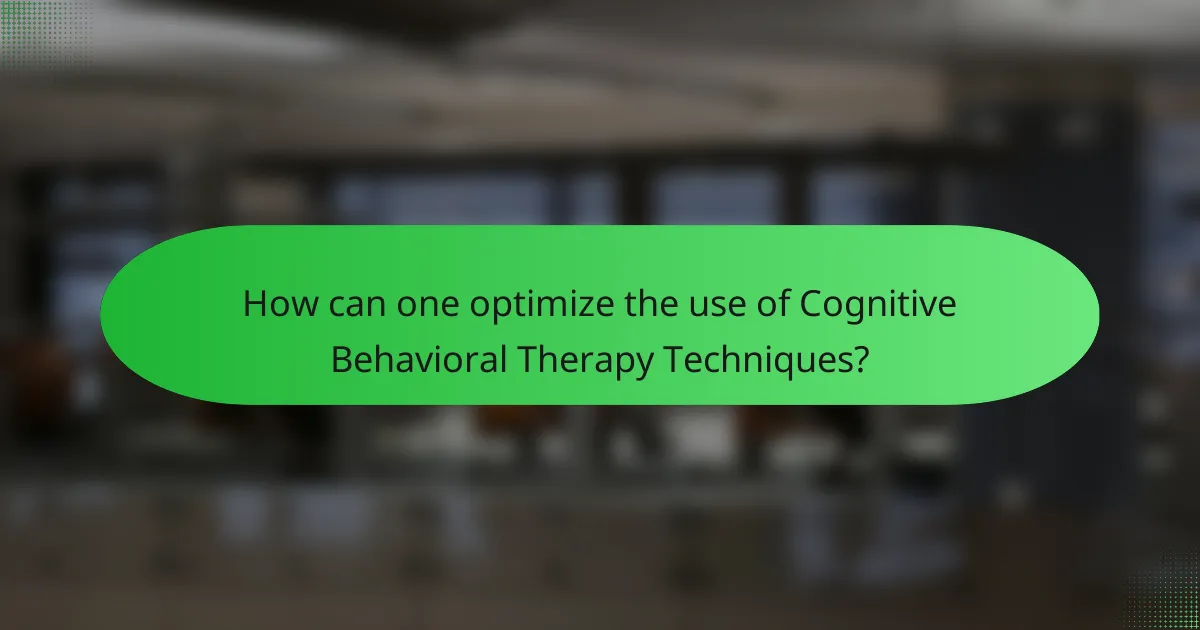
How can one optimize the use of Cognitive Behavioral Therapy Techniques?
To optimize the use of Cognitive Behavioral Therapy techniques, focus on consistent practice and personalization. Regularly applying techniques like cognitive restructuring and exposure therapy enhances emotional resilience. Tailor approaches to individual needs, ensuring they align with personal goals for growth. Utilize journaling to track progress and identify patterns, facilitating deeper insights into thought processes. Engage in group therapy or support systems for additional perspectives and encouragement, reinforcing the application of learned skills.
What are best practices for integrating CBT into a personal development plan?
Integrating Cognitive Behavioral Therapy (CBT) into a personal development plan enhances emotional resilience. Start by identifying specific goals related to personal growth. Use techniques such as cognitive restructuring to challenge negative thoughts, and practice behavioral activation to engage in positive activities. Regularly track progress through journaling or self-reflection to maintain motivation. Finally, consider seeking professional guidance for tailored strategies and support.
Which common mistakes should be avoided when practicing CBT?
To practice Cognitive Behavioral Therapy (CBT) effectively, avoid common mistakes such as neglecting to set clear goals, skipping homework assignments, and focusing solely on negative thoughts. These pitfalls can hinder personal growth and emotional resilience. Additionally, failing to engage in self-reflection and not seeking feedback can limit progress. Recognizing these errors is essential for maximizing the benefits of CBT.
How can ongoing education enhance the effectiveness of CBT techniques?
Ongoing education enhances the effectiveness of CBT techniques by deepening understanding and improving application. Continuous learning allows practitioners to stay updated on the latest research, techniques, and tools, which can lead to more effective interventions. Additionally, education fosters the development of new skills that can be integrated into therapy sessions, enhancing client engagement and outcomes. Regular training helps therapists refine their approach, adapt to diverse client needs, and maintain high standards of practice. This commitment to growth ultimately strengthens the therapeutic relationship and promotes lasting emotional resilience in clients.
